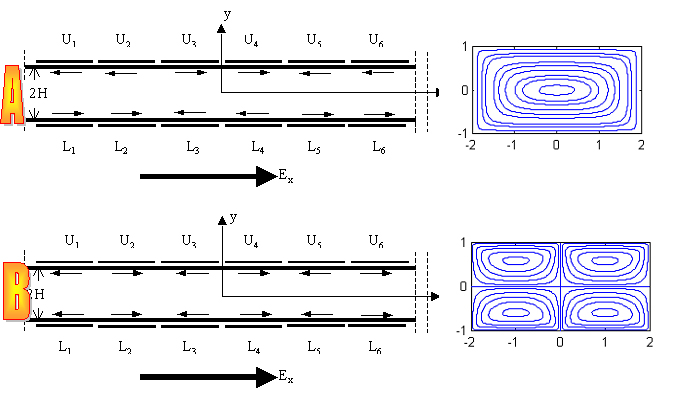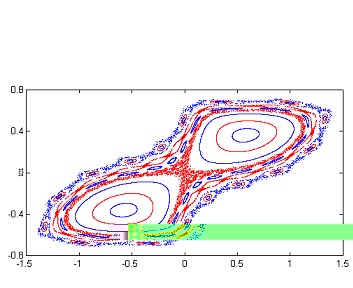ELECTROOSMOSIS
The electroosmotic phenomenon is caused by the accumulation of a net electric charge on the solid’s surface that is in contact with an electrolyte solution and the accumulation of counterions in a thin liquid (double or Debye) layer next to the solid’s surface. Away from the solid’s surface, the electrolyte is neutral. In the presence of an external (driving) electric field, the counterions in the Debye layer are attracted to the oppositely charged electrode and drag the liquid along. In other words, the electric field, through its effect on the counterions, creates a body force that, in turn, induces fluid motion. Electroosmosis is often used to propel liquids in microdevices. Our research focuses on controlling the surface charge locally. The control is accomplished by embedding individually controlled electrodes beneath the liquid-solid interface. The electrodes are insulated from the liquid. By applying an electric potential between the embedded electrodes and the liquid, one can control the surface charge. This can be used to control fluid motion in microfluidic networks. Moreover, by judicious control of the surface charge in the presence of a driving electric field, it is possible to induce complex flows that may be beneficial to stirring.
CHAOTIC ELECTROOSMOTIC STIRRERS
FIG 1: A conduit is equipped with individually controlled electrodes (Ui) and (Li) embedded, respectively, in the upper and lower walls. These electrodes are used to control the z potential at the solid/liquid interface. The arrows in the channel denote the directions of the electroosmotic velocities that were used to generate flow patterns A (top image) and B (lower image).
FIG 2: When the flow patterns A and B alternate at high frequency, chaotic islands evolve. The figure depicts the stroboscopic images (Poincare sections) of passive tracer particles. At low alternating periods, the passive tracer particles visit almost the entire area of the cross-section.
CHAOTIC ELECTROOSMOTIC STIRRERS
We use polarization forces for directed positioning of particles and macromolecules at desired locations, and we study the forces that act on particles suspended in solution under the action of electric fields. In our theoretical studies, we account for the polarization of the electric double layer that envelops the particles.
DIELECTROPHORESIS
 FIG 3: Polarization forces are used to trap actin filaments across a gap between two electrodes
FIG 3: Polarization forces are used to trap actin filaments across a gap between two electrodes
FIG 4: Movie of vibrating actin filaments
Keywords: electroosmosis, nonlinear, electrophoresis, translocation, DNA, dielectrophoresis, particle, rod, wall, nanotubes
PUBLICATIONS
- Henry, C. S., Zhong, M., Lunte, S. Kim, M., Bau, H., and Santiago, J., 1999, Ceramic Microchip for Capillary Electrophoresis-Electrochemistry, ANALYTICAL COMMUNICATIONS 36, (8) 305-307.
- Qian, S. and Bau, H. H., 2002, A Chaotic Electroosmotic Stirrer, Analytical Chemistry, 74 (15): 3616-3625.
- Qian, S., and Bau. H., H., Chaotic Electroosmotic Stirrer, IMECE 2002-33763, Proceedings of IMECE’02, 2002 ASME International Mechanical Engineering Congress & Exposition, New Orleans, Louisiana, November 17-22, 2002.
- Liu, H., Bau, H. H., Hu, H., 2004, Electrophoresis of Concentrically and Eccentrically Positioned Cylindrical Particles in a Long Tube, Langmuir 20(7), 2628-2639.
- Qian, S. and Bau, H., H., 2005, Theoretical Investigation of Electroosmotic Flows and Chaotic Stirring in Rectangular Cavities, Applied Mathematical Modeling, 29 (8), 726-753.
- Liu, H., and Bau, H. H., 2004, The Dielectrophoresis of Cylindrical and Spherical Particles Submerged in Shells and in Semi-infinite Media, Physics of Fluids 16, 1217-1228.
- Evoy, S. DiLello, N., Deshpande, V., Narayanan, A., Liu, H., Riegelman, M., Martin, R., R., Hailer, B., Bradley, J.-C., Weiss, W., Mayer, T. S., Gogotsi, Y., Bau, H. H., Mallouk, T. E., and Raman, S., 2004, Dielectrophoretic assembly and integration of nanowire devices with functional CMOS operating circuitry, Microelectronic Engineering 75, 31–42.
- Riegelman, M., Liu, H., and Bau, H. H., 2006, Controlled Nano-Assembly and Construction of Nanofluidic Devices, Trans ASME, J. Fluid Engineering 128, 6-13.
- Liu, H., Qian, S., and Bau, H., H., 2007, The Effect of Translocating Cylindrical Particles on the Ionic Current through a Nano-Pore, Biophysical Journal 92: 1164-1177
- Zhao, H., and Bau, H., H., 2007, On the Effect of Induced Electro-Osmosis on a Cylindrical Particle Next to a Surface,Langmuir 23, 4053-4063.
- Zhao, H., and Bau, H. H., 2007, Microfluidic chaotic stirrer utilizing induced-charge electroosmosis, Phys. Rev. E, 75, 066217 (1-8).
- Arsenault, M., Zhao, H., H., Purohit, P., Goldman, Y., and Bau, H. H., 2007, Confinement and Manipulation of Actin Filaments by Electric Fields, Biophysical Journal, 93, L42-L44.
- Zhao, H., and Bau, H., H., 2008, The Effect of Double layer polarization on the forces that act on a nanosize, cylindrical particle in an AC electric field, Langmuir 24, 6050-6059.
- Zhao H., and Bau, H., H., 2009, The Polarization of a Nano Particle Surrounded by a Thick Electric Double Layer, Journal of Colloid & Interface Science 333, 663-671, http://dx.doi.org/10.1016/j.jcis.2009.01.056
- Zhao, H., and Bau, Haim, H., 2010, The Polarization of Nanorods Submerged in an Electrolyte Solution and Subjected to an AC Electric Field, Langmuir 26, 5412-5420, DOI: 10.1021/la903842z.
- Han-Sheng Chuang, David Raizen, Anesia Lamb, Nooreen Dabbish, and Haim Bau, 2011, Dielectrophoresis of Caenorhabditis elegans, Lab on Chip 11, 599-604 DOI: 10.1039/C0LC00532K


